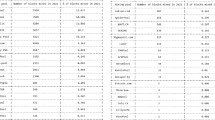Abstract
Theoretical studies show that a block withholding attack is a considerable weakness of pool mining in Proof-of-Work consensus networks. Several defense mechanisms against the attack have been proposed in the past with a novel approach of sending sensors suggested by Lee and Kim in 2019. In this work we extend their approach by including mutual attacks of multiple pools as well as a deposit system for miners forming a pool. In our analysis we show that block withholding attacks can be made economically irrational when miners joining a pool are required to provide deposits to participate which can be confiscated in case of malicious behavior. We investigate minimal thresholds and optimal deposit requirements for various scenarios and conclude that this defense mechanism is only successful, when collected deposits are not redistributed to the miners.
Access this chapter
Tax calculation will be finalised at checkout
Purchases are for personal use only
Similar content being viewed by others
References
Eyal, I., Sirer, E.G.: Majority is not enough: bitcoin mining is vulnerable. In: Conference Paper (2013)
Eyal, I.: The Miner’s dilemma. In: IEEE Symposium, Security and Privacy, pp. 89–103 (2015)
Eyal, I., Sirer, E.G.: Majority is not enough: bitcoin mining is vulnerable. Commun. ACM 61, 95–102 (2018)
Lee, S., Kim, S. Countering block withholding attack efficiently. In: IEEE INFOCOM (2019)
Luu, L., Saha, R., Parameshwaran I., Saxena P., Hobor A.: On power splitting games in distributed computation: the case of bitcoin pooled mining. In: 2015 IEEE 28th Computer Security Foundations Symposium (2015)
Rosenfeld, M.: Analysis of bitcoin pooled mining reward systems. arXiv, 1112.4980 (2011)
Zhu, S., Li, W., Li, H., Hu, C., Cai, Z.: A survey: reward distribution mechanisms and withholding attacks in Bitcoin pool mining. Math. Found. Comput. 1(4), 393–414 (2018)
Acknowledgements
We would like to thank Michael Zargham (BlockScience, USA), Jamsheed Shorish (ShorishResearch, Belgium), and Hitoshi Yamamoto (Rissho University, Japan) for their useful comments. We thank Alfred Taudes (former Director of the interdisciplinary Research Institute for Cryptoeconomics at the Vienna University of Economics) for his management of our project.
Author information
Authors and Affiliations
Corresponding author
Editor information
Editors and Affiliations
A Proof of Theorems
A Proof of Theorems
1.1 A.1 Proof of Theorem 1
Proof
(Theorem 1). If no attacks occur in the network both \(x=y=0\) by definition. Plugging both in into Definition 1 we get
and
which respecting Definition 2 yields
and
Due to Definition 3 we get \(E_A = E_B = 1\).
1.2 A.2 Proof of Theorem 2
Proof
(Theorem 2). For \(x > 0\) and \(y=0\) plugging in into 1 yields
and
which again can be inserted into 2 and thus since \(y=0\) then \(R_B\) reduces to
which can be plugged into \(R_A\)
and therefore both efficiencies compute as:
and
This shows that \(E_A>E_B\) because
This is true because \(( x - x^2)>0\) as \(x<1\). This further shows that \(E_B < 1\) because:
since the denominator is greater than the numerator. Further we show when \(E_A>1\):
which is the case when
Rights and permissions
Copyright information
© 2022 The Author(s), under exclusive license to Springer Nature Switzerland AG
About this paper
Cite this paper
Okada, I., De Silva, H., Paruch, K. (2022). Sending Spies as Insurance Against Bitcoin Pool Mining Block Withholding Attacks. In: Kotsis, G., et al. Database and Expert Systems Applications - DEXA 2022 Workshops. DEXA 2022. Communications in Computer and Information Science, vol 1633. Springer, Cham. https://doi.org/10.1007/978-3-031-14343-4_23
Download citation
DOI: https://doi.org/10.1007/978-3-031-14343-4_23
Published:
Publisher Name: Springer, Cham
Print ISBN: 978-3-031-14342-7
Online ISBN: 978-3-031-14343-4
eBook Packages: Computer ScienceComputer Science (R0)




